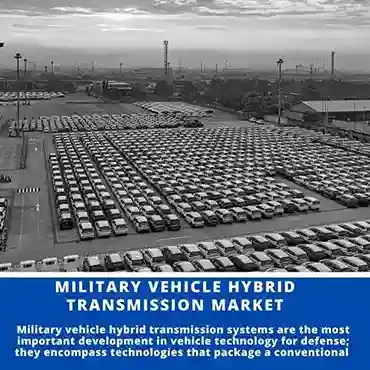
- Get in Touch with Us

Last Updated: Apr 25, 2025 | Study Period: 2024-2030

The emerging trend of new technologies, operational imperatives, and environmental thoughts is rapidly improving the military vehicle hybrid transmission market. Hybrid transmission systems are down the road in which comparatively conventional internal combustion engines are integrated with electric propulsion technologies. New technologies promise great improvement in fuel efficiency, operational flexibility, and sustainability. These are state-of-the-art technology-based systems integrated with advanced, electric, or energy storage solutions that have attained high sophistication through battery or ultracapacitor use and a set of control algorithms. These integrate the design of power management and efficiency over a wider range of military vehicles and address the challenges of fuel consumption, logistical support, and also operational capabilities in different mission scenarios.
The major idea or concept behind hybrid transmission systems is the hybridization of simplistic internal combustion engine technology together with state-of-the-art electric propulsion systems. Such systems incorporate advanced electric motors, which work simultaneously with traditional engines, and supplement the energy storage and supply by batteries or ultracapacitors. The power distribution among these components is managed by advanced control algorithms, in order to tailor the energy transmission in the course of its optimization.
The development of better motor efficiencies, battery energy density, and the design of regenerative braking technologies, in turn, with the advanced properties in electric propulsion systems, have led to the evolution of the technology of a hybrid transmission. With further research and development, the technologies associated with hybrid transmissions will be further developed and fine-tuned in order to make it cheaper, reliable, and deployable on a large scale with defense forces around the world.
Hybrid propulsion systems within a military vehicle are an attempt to marry conventional internal combustion engines with electric drive technologies in the quest for fuel efficiency gains and performance while delivering gains in environmental benefit. The most advanced propulsion systems for military vehicles are a combination, of course, of electric motors working with energy storage solutions ranging from batteries to ultracapacitors and state-of-the-art control technologies capable of effectively managing power. Hybrid transmission systems enable silent operation in electric mode for military vehicles, a key technical factor in stealth missions and combat conditions. These show a technological evolution toward this greater efficiency, sustainability, and flexibility in military applications.
Military vehicle hybrid transmission systems are the most important development in vehicle technology for defense; they encompass technologies that package a conventional internal combustion engine with new and advanced electric propulsion technologies. They have been very carefully engineered to be as fuel-efficient as possible while maximizing the performance of operating and meeting strict environmental criteria.
In conclusion, hybrid transmission systems for military vehicles constitute one of the most important technological advances within defense vehicles, thanks to the balance between traditional power and new electric propulsion features. These systems lead to an improvement not only in operational performance and flexibility but are also of tremendous importance in reducing fuel consumption and emissions in pursuit of sustainability objectives. In mature markets with continued technological upgrades and increasing recognition by defense forces worldwide, hybrid transmission systems will be a key enabler for better military operations, improved mission readiness, and adjustment to the complex demands of warfare in today's contemporary era.
BAE Systems
BAE Systems takes an innovative approach to developing military vehicle technologies, including hybrid transmissions. Currently, they are focusing on the use of leading advanced composite materials to innovate lightweight vehicle components that are extremely strong in terms of weight, yielding better mobility without any loss of durability. Reducing the overall weight of a transmission system, BAE Systems works toward better fuel efficiency and an extended operational range for vehicles under performance in diverse terrain conditions. The development by the company also incorporates the transmission of such lightweight materials in the hybrid transmission system design for operating military requirements.
Rheinmetall AG
Rheinmetall AG is resorting to automated assembly technologies and robotics to create innovative manufacturing processes for hybrid transmission systems. Automation encompasses critical stages of production in Rheinmetall to introduce efficiency and consistency in its productions. Automatic systems ensure that highly complex transmission systems are put together with accuracy to eliminate human error and variation. Such methods also improve product reliability and uniformity among production batches by meeting very tight quality standards required for military applications. Rheinmetall invests in robotics to support its goals for increasing manufacturing throughput while maintaining
Oshkosh Defense
Oshkosh Defense continues to advance precision machining techniques and additive manufacturing capabilities in the production of intricate hybrid transmission components with exceptional durability and reliability.
Precision machining allows for fabrication of key transmission components to very close tolerances that ensure optimum functionality and long life under the toughest operating conditions. Additionally, their use of additive manufacturing technology, or 3D printing, can achieve parts with geometries and configurations that it would be hard for more traditional forms of production to duplicate. These flexible methods of production lead to rapid prototyping, process design changes, and manufacturing for such hybrid power transfer systems based on one-of-a-kind military vehicle requirements. General Dynamics Corporation General Dynamics Corporation has attempted to stave off the need for assembly and maintenance process upgrades of hybrid transmission subcomponents that are intended for military platform use.

By Geography:
Vehicle Type:
Technology Type:
Application:
| Sl.no | TOPIC |
| 1 | Market Segmentation |
| 2 | Scope of the report |
| 3 | Research Methodology |
| 4 | Executive Summary |
| 5 | Introduction |
| 6 | Electromechanical Actuators can be used in the market |
| 7 | R&D in the military vehicle hybrid transmission market |
| 8 | Durability and Reliability Testing are obtained |
| 9 | Integration of Powertrain Components are used military vehicle hybrid market |
| 10 | Operational Benefits in military vehicle hybrid market |
| 11 | Cost breakdown of Product by sub-components and average profit margin |
| 12 | Disruptive innovation in the Industry |
| 13 | Technology trends in the Industry |
| 14 | Consumer trends in the industry |
| 15 | Recent Production Milestones |
| 16 | Component Manufacturing in US, EU and China |
| 17 | Average B-2-B selling price in past 5 years |
| 18 | Competition from substitute products |
| 19 | New product development in past 12 months |
| 20 | Market Size, Dynamics and Forecast by Vehicle Type , 2024-2030 |
| 21 | Market Size, Dynamics and Forecast by Technology Type , 2024-2030 |
| 22 | Market Size, Dynamics and Forecast by Application , 2024-2030 |
| 23 | Market Size, Dynamics and Forecast by Geography , 2024-2030 |
| 24 | Competitive Landscape |
| 25 | M&A in past 12 months |
| 26 | Growth strategy of leading players |
| 27 | Market share of vendors, 2023 |
| 28 | Company Profiles |
| 29 | Unmet needs and opportunity for new suppliers |
| 30 | Conclusion |